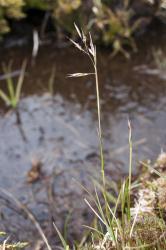- Taxon
- Gallery
- ≡ Danthonia semiannularis var. nigricans Petrie, Trans. & Proc. Roy. Soc. New Zealand 46: 37 (1913 [1914])
- ≡ Danthonia nigricans (Petrie) Calder, J. Linn. Soc., Bot. 51: 8 (1937)
- ≡ Danthonia gracilis var. nigricans (Petrie) Zotov, Trans. Roy. Soc. New Zealand 73: 234 (1943)
- ≡ Notodanthonia nigricans (Petrie) Zotov, New Zealand J. Bot. 1: 123 (1963)
- ≡ Thonandia nigricans (Petrie) H.P.Linder (1996) nom. illeg.
Open tufts, rather stiffly erect; leaves about ½ length of culms to only slightly shorter; branching extravaginal. Leaf-sheath brownish or often purplish above, glabrous or long-hairy; apical tuft of hairs 1.5–2.5 mm. Ligule ± 0.2 mm. Leaf-blade to 15–(20) cm, usually folded, sometimes flat and margins inrolled, to 2 mm wide, glabrous or often a few scattered long hairs near collar, sometimes almost all leaves with some long hairs, margins occasionally finely scabrid. Culm to 30–(50) cm, internodes smooth but minutely scabrid below inflorescence. Panicle usually erect, dark purple, to 3.5–(8.5) cm; rachis and pedicels densely but shortly scabrid, often with very slightly longer hairs above branch axils. Spikelets 3–(4)-flowered, awns exserted from glumes. Glumes usually dark purplish centrally, lanceolate, acute to acuminate, 6.5–9 mm, ± equal, 3–(5)-nerved. Lemma 1.5–2.5 mm, 9-nerved, upper row of hairs continuous, > or ≈ lemma lobes, lower row of marginal tufts and a few weak central tufts, or ± continuous, elsewhere predominantly glabrous, occasionally some few isolated hairs between rows, margins hair-fringed; lobes 2.7–3.5 mm, tapering, awnless or very finely awn-tipped; central awn 6–8.5 mm, column 1–1.5 mm < upper lemma hairs. Palea 2.5–3 mm, « upper lemma hairs, interkeel and margins glabrous or occasionally 1–2 long hairs. Callus 0.2–0.3–(0.5) mm, a few short scattered marginal hairs not, or barely, reaching lower lemma hairs. Rachilla 0.8–1.2 mm. Anthers 0.5–0.8–(1.1) mm. Caryopsis 1.1–1.3 × 0.6 mm; embryo 0.5–0.7 mm; hilum 0.2–0.3 mm. 2n= 24. Plate 12H.
[From: Edgar and Connor (2000) Flora of New Zealand. Volume 5 (second printing).]




